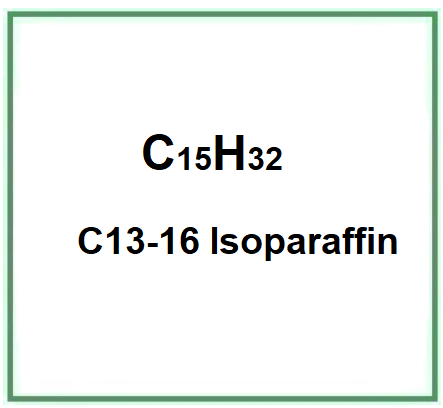C13-16 isoparaffin is a chemical compound, branched hydrocarbon chain, obtained from crude oil by various chemical processes including hydrodeoxygenation-hydroisomerisation, a catalytic process that converts normal paraffin to isoparaffin. The numbers indicate the carbon atoms in the alkyl chain. It is very similar to Cyclopentasiloxane.
The name describes the structure of the molecule
- "C13-16". This numeric designation indicates the range of carbon chain lengths of the isoparaffins present. In this case, the isoparaffins in the mixture have carbon chains ranging from 13 to 16 carbon atoms.
- "Isoparaffin". Isoparaffins are saturated, branched hydrocarbons (i.e., non-linear) that are components of paraffinic hydrocarbons. They are often used in cosmetics and skincare products as emollients and texture agents.
Description of raw materials used in production
- C13-16 Isoparaffins. These are a range of low-viscosity saturated aliphatic hydrocarbons. They are petroleum-derived compounds used as emollient agents or as solvents in various products
Step-by-step summary of industrial chemical synthesis process
- Petroleum Refinement. Isoparaffins are obtained through fractional distillation of crude petroleum, where they are separated based on their chain length and boiling point.
- Hydrogenation. Once separated, these molecules undergo a hydrogenation process to increase their saturation and stability.
- Purification. After hydrogenation, the isoparaffins undergo further purification processes to remove any impurities.
It appears as a colourless viscous liquid. Viscosity index 11 at 25°C.

What it is used for and where
Cosmetics
Compound very similar to Cyclopentasiloxane (CAS 541-02-6) but with different viscosity.
Solvent. It is the substance for dissolving or dispersing surfactants, oils, dyes, flavourings, bactericidal preservatives in solution.
Doses
Cosmetics for make-up, skin care, based on essence oil: 2~20%.
Commercial applications
Cosmetic Industry. Owing to their light texture and ability to form a barrier on the skin, isoparaffins are often used as emollients in creams, lotions, and skincare products. Moreover, they act as solvents for many water-insoluble substances.
Other Industrial Uses. Beyond the cosmetic industry, C13-16 isoparaffins are employed in a variety of products such as lubricants, hydraulic fluids, and as solvents in paints and inks.
Properties and Benefits.
Non-Comedogenic. The light structure of C13-16 isoparaffins ensures that they don’t clog pores, making them ideal for skincare products.
Emollient. They provide a soft, smooth feeling on the skin.
Stable. C13-16 isoparaffins are chemically stable, making them suitable for multiple applications without easily degrading.


- Molecular Formula C15H32
- Molecular Weight 212.41 g/mol
- CAS 68551-20-2 1560-95-8
- UNII 6V30XLA02Y
- EC Number 271-370-0
- Nikkaji Number J450.758D
- DTXSID90873240
Synonyms:
- Tetradecane, 2-methyl-
- Alkanes, C13-16-iso
- 2-Methyltetradecane
Trade name
References_____________________________________________________________________
BÄHRLE-RAPP, Marina; BÄHRLE-RAPP, Marina. C11–13 Isoparaffin. Springer Lexikon Kosmetik und Körperpflege, 2007, 113-113.
![]() C13-16 isoparaffin
C13-16 isoparaffin 



